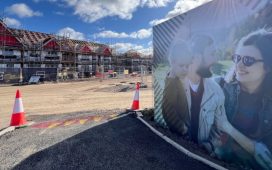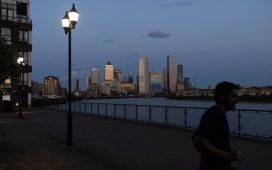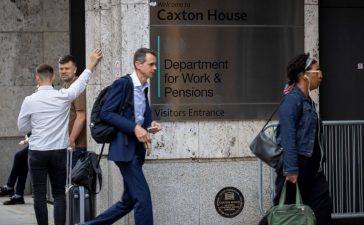For many of the residents of Mar House, the past year has been spent in perpetual twilight.
The seven-storey block in Colindale, north London, is cloaked in blue netting and scaffolding that shroud its rooms in shadow in the middle of the day. The netting is for work to replace the building’s flammable Grenfell-style cladding and wooden balconies.
But there is little sign of the gloom lifting in the 95-apartment block. While work began in April 2022, with the scaffolding starting to go up last year, it has been on hold since May. The contractor walked off site after removing the cladding, owed £700,000 by the block’s freeholder, Old House Group.
The cladding paralysis is just one in a string of problems that have plunged Mar House residents – who bought their flats to achieve their home-owning dream – into a leasehold nightmare.
They now face a winter with no cladding, trapped in flats they cannot find buyers for, while the block’s freeholder fell into administration in June. Meanwhile, the blame for their plight is entangled in conflicting allegations made by the multitude of companies involved in managing the block.
The experiences of Mar House’s leaseholders will chime with many of England’s 3.4 million leaseholders living in flats who face daily struggles with cladding issues, unaffordable and often opaque service charges, and a feeling of powerlessness, while government efforts to tackle the leasehold scandal drag on.
Foot on the ladder
On the top floor, Martin Raychev thumbs through a ring binder filled with hundreds of sheets of paper. It chronicles the multitude of problems he has faced since buying the one-bedroom, £323,000 leasehold flat in 2015: letters to MPs, service charge notices (including one for £65,000), and a council notice warning of multiple fire hazards in the block.
In leasehold – a common form of home ownership, particularly with flats – the buyer buys the right to live in a property for a given period. The leaseholder pays a regular ground rent and service charge to the freeholder of the property and has to follow the conditions set out in the lease.
“It’s like having a part-time job,” Raychev says of the encyclopaedia of complaints. “It’s been terrible.”
Others have given up living in the block. Krishna Panchal moved out of her flat and into her husband’s family’s home in Surrey last year. “When I was pregnant with my daughter we just felt it wasn’t a suitable environment for a child, with the construction going on and no access to our balconies,” she says.
Unable to find a buyer because of the fire safety issues making it near-impossible to secure a mortgage, she is stuck paying 75% of her wage for an empty apartment.
It was not meant to be like this. Completed in 2016 by a now-dissolved developer, Mar City Homes, the £26m project was described by the mayor of London’s office under Boris Johnson as an “innovative example” of a development using modular construction techniques.
With Colindale identified as one of Johnson’s “opportunity areas”, the block – including 15 leasehold and 31 shared ownership flats, with the rest social housing – was attractive for first-time buyers.
“I was elated when I first moved in,” says Panchal, who bought her shared ownership home in Mar House in 2016. Within seven months, the problems started when a pipe burst.
“I came home from holiday and there was just a big pool of water in the kitchen and everything was water damaged,” she says.
She would later have to pay thousands of pounds to redecorate and get flooring redone after more leaks in 2021.
“It’s like living in a nightmare,” she says. “I feel I’ve put my family in a position we can’t get out of.”
Several other residents have had similar issues with leaks, which have damaged property and possessions. The poor standard of construction is underlined by improvement notices issued by the London Borough of Barnet in 2022, which raised concerns about damp and mould and problems with the gas supply.
Leaseholders also have five claims out against the building’s warranty provider, the National House Building Council (NHBC).
The shadow of Grenfell
The Grenfell Tower fire in June 2017 was the deadliest residential fire in the UK since the second world war, and 72 people lost their lives in the west London block. A later inquiry into the tragedy would conclude the flammable aluminium composite material (ACM) cladding as the primary cause for the fire.
In October 2019, Mar House residents were informed that their homes were wrapped in the same cladding. They were among 514 properties – mainly blocks of flats – across the UK found to have been clad in ACM.
Weeks later they were asked to sign forms that could give the block access to the government’s £200m “ACM fund”, set up to accelerate the replacement of the deadly materials.
A waking watch, which involves physical patrols of the block 24 hours a day looking for fires, was also set up, and residents were told work should start in May 2020.
Four years on and the cladding has yet to be replaced – it is one of only 60 of the 514 ACM-clad buildings in England that has not had its cladding replaced. The fire watch is still in place, at a cost of thousands of pounds per leaseholder, and the building’s freeholder, responsible for the block’s safety, is in administration.
As leaseholders waited for the cladding removal to start, behind the scenes and largely unbeknown to them, Old House Group (OHG) bought the freehold for £1.7m from South Staffs Group in September 2020.
OHG was set up in February 2019 by managing director Nasser Alanizy. A 41-year-old director of more than 20 companies, mostly property firms, his portfolio also includes an insurance agent and metal door manufacturer.
Despite freeholders being ultimately responsible for the safety and finances of blocks, UK property law has few rules on who can own a freehold. “Anyone can come along, set up a company, buy a freehold, start charging a service charge, without any checks whatsoever,” says Martin Boyd, the chair of trustees at the Leasehold Knowledge Partnership, a charity for leaseholders.
But why would OHG want to buy a block with cladding problems? Administrators at Quantuma Advisory describe OHG as not trading in the “conventional sense”, with its sole purpose being to fix the cladding, develop the building, and receive a return through sale.
In August 2020, just a month before OHG bought Mar House’s freehold, the government introduced new rules allowing freeholders to add two floors on to blocks with no planning permission.
These “permitted development rights” were brought in with the aim of increasing housing numbers, but campaigners warned it would provide a windfall to freeholders.
By November, OHG had put in an application to add two extra storeys to Mar House, which would include 34 additional flats. In June 2021 the plan got the green light from Barnet council, despite 17 objection letters, compared with just one in support.
Construction never began, but Raychev, who would have been forced to move out of his top-floor flat if it had, says this marked the start of the problems under OHG.
Passing the buck
The management of residential blocks in England follows a similar structure. Freeholders employ managing agent companies, often for several years, to manage the maintenance and repairs of a block, while collecting the service charge from leaseholders to pay for this.
This multilayered system of responsibility was even more complex at Mar House. Four subsequent managing agents were appointed in the first 18 months of OHG’s ownership.
after newsletter promotion
Pinnacle, the agent at the time OHG took over, stayed on for just seven months under OHG, telling the Observer it had terminated its contract after its significant but unspecified concerns regarding the freeholder meant it could no longer continue its relationship.
Arrow Leasehold Management, which was in place between June and October 2021, left after finding serious financial concerns it could not resolve, including what it said was a potential £276,000 deficit in the building’s service charge fund.
In an email to residents announcing its exit, it claimed that OHG was refusing to pay its portion of the service charge, which was adding to the lack of funds.
Its replacement, Solum Estates, left after accusing the OHG of “fraudulently sending invoices to residents using its letterheads” to demand back payments of service charges from leaseholders.
It did confirm, however, that while the stationery had been used without its authority, the demand was for money to be paid into a bank account Solum had opened, and not one controlled by the freeholder. Solum said it had stopped managing Mar House five days after being told by residents about the demands for money.
OHG has called the accusation of fraud “baseless” and confirmed that the account had the managing agent’s bank details on it.
The fourth managing agent, a company called Benjamin Stevens, was in place between January 2022 and May 2023, but its tenure included complaints from leaseholders over service charge demands.
This included one resident, Neal Dadia, who was issued a letter in 2023 that included service charge arrears totalling £75,000. He bought his flat for £305,000.
This came after he had extended the terms of his mortgage to pay £8,000 in service charge arrears in 2020.
Benjamin Stevens said it was not asking Dadia to pay £75,000, but needed to issue the charges to demonstrate proof to warranty provider NHBC. “This is why the charges for cladding and health and safety works were raised on the accounts: NHBC needed them to consider a payout for the costs incurred,” it said.
It added: “The NHBC claims are against the warranty for each individual flat, so this is why each flat had to ‘incur’ the charge the NHBC were being asked to cover under the warranty.”
It said it was always happy to go through costs with leaseholders and that it was ultimately the freeholder who made decisions on how much leaseholders were charged.
At the end of 2022, Sanctuary, a housing association that owns the long leasehold on 79 homes, became so frustrated with OHG’s management of the block that it applied to the first-tier property tribunal to remove its management powers.
The case was settled before it got to court and an independent managing agent, Maunder Taylor, was brought in May 2023.
OHG said all of the issues with the block predated its involvement and it discovered them after buying the freehold.
It claimed that Sanctuary was involved in the development of the block and therefore had a responsibility to pay for and fix these defects, and that these sums were never paid.
It added that it had been unable to recover these costs from Sanctuary, so as a result had to cover the leaseholders’ costs itself. It also said that all managing agents had been recommended by leaseholders.
A spokesperson for Sanctuary denied the claims and said it had no association with Mar City Homes, and was a leaseholder of individual flats and therefore had “no control over the structure or external parts of the building, and no legal right to carry out any works”. The spokesperson added that they “share the frustrations of residents” that the defects with the block had yet to be resolved.
A trail of debts
In April this year OHG’s financial problems became public.
The architect appointed to design the two additional floors at Mar House, Ackroyd Lowrie, issued a petition to wind up the company. More creditors would appear.
OHG had taken a loan from the specialist property lender KSEYE to buy the freehold of the property, using the building as security.
After refinancing the loan several times, it missed a payment deadline and receivers were appointed to the property in May.
Subsequent documents revealed that OHG had not made any loan repayments and owed KSEYE £3.7m, including the initial loan, interest and charges. OHG denies this and says payments were made.
Administrators found that Alanizy had refinanced several other properties he was linked to, all with KSEYE, with the overall amount owed understood to be £5.3m.
The businessman’s debts stretched to other lenders, too. In July 2021, Alanizy’s Wilton Place Ltd took out a £6.4m bridging loan to fund the purchase of a Grade II-listed townhouse in Belgravia from lenders CapitalRise. Receivers were appointed in February this year.
OHG entered administration in June this year.
Administrators’ proposals revealed OHG went under owing £1.2m to creditors, including £12,000 to British Gas and £330,000 to Pro Sentry, a company that carried out the waking watch at Mar House, as well as the unpaid £700,000 that led cladding contractor T&T Facades to walk off site. The Observer understands that T&T intends to return to site at some point, but leaseholders are in the dark over when work will be completed.
It is also understood that an offer has been accepted from a new buyer after the block’s freehold was put up for auction.
But there is hope that future leaseholders could be spared what residents at Mar House have experienced. In the final days of the Conservative government, it made the Leasehold and Freehold Reform Act law, making it easier for leaseholders to manage their building, while providing greater transparency over service charges.
Labour has pledged to go further, and included the leasehold and commonhold reform bill in the King’s speech. The bill aims to “bring the feudal leasehold system to an end” and would completely ban the sale of new leasehold flats so that commonhold, which does not require a freeholder, becomes the default tenure.
However, after pre-election promises to abolish leasehold in its first 100 days, this has now been pushed back to the end of parliament, much to the frustration of campaigners.
For leaseholders such as Raychev, the changes can’t come soon enough. “This period has been really terrible for me,” he says. “In 2025, this [leasehold] system should not exist.”









